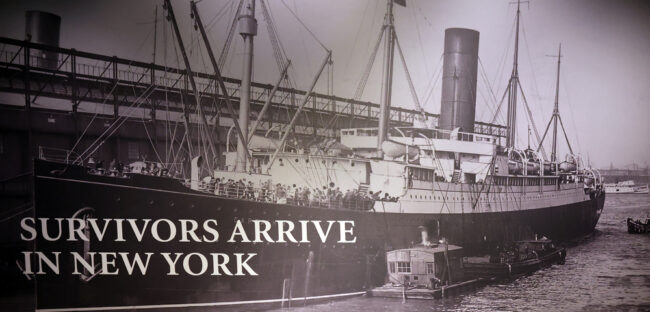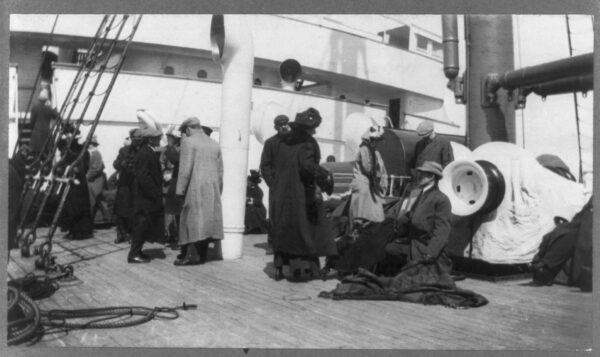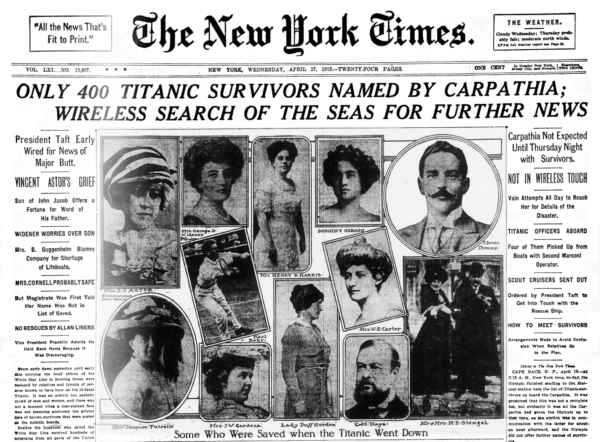Most of us know of the devastating lack of lifeboats onboard the Titanic and the resulting huge loss of lives. But did you know that the Titanic had enough life jackets to go around for all the passengers and crew?
So why did so many individuals perish? Turns out that the frigidly cold waters were the primary culprit. Keep reading to learn just how cold the water was when the Titanic sank and why that exacerbated the death toll.

How Cold Was The Water When The Titanic Sank & Why It Matters
More than a hundred years after the night Titanic sank, it is hard to imagine the fear of crew and passengers staring at the icy water and wondering if they would survive. Passengers and crew not fortunate to climb into a lifeboat would have experienced water, 28°F, which is 2 degrees below freezing. That’s cold enough to kill in minutes.
Dangers of Immersion Hypothermia
Most of the people who died in the waters surrounding the Titanic perished from immersion hypothermia. It is a condition that occurs after prolonged exposure to cold water. The body’s core temperature drops below normal levels due to heat transfer from the body to the surrounding cold water.
When immersed in water, your body loses heat much more quickly than when you’re standing on land. So, for instance, walking around in 50-degree weather does not seem particularly life-threatening. Some people would find that brisk and enjoyable.

In contrast, staying in a body of water that’s 50 degrees can lead to death in about an hour.
If a Titanic-level incident had occurred in the Mediterranean Sea (average temperatures in the 60’s and 70’s) or the Caribbean (average temperatures in the 80’s), it still would have been tragic. But far more people could have been rescued.
Why Was The Water 28°F Where Titanic Sank?
On the night that the Titanic encountered its iceberg, the temperatures were unusually cold.
The area where the Titanic sank is known as the “Iceberg Alley” due to the many icebergs that travel through the eastern straight. Icebergs travel on Newfoundland’s eastern coast, Grand Banks, through the east straight toward the Gulf Stream, where it melts in the warmer water.
Temperatures in that area are usually in the mid-40s, with the water closer to ice being a bit colder. However, on that day in April, high-pressure cold fronts from Canada were driving the temperatures lower.
It happens that the captain of the SS Californian, a ship that was relatively close to where the Titanic sank, had measured the water temperature during this time period and noted that it was consistently below freezing on April 14 and April 15. The lowest measurement he recorded was 28°F.
Most People Ended Up In The Water
The Titanic was believed to be unsinkable because of the design concerning watertight compartments. The ship had 16 watertight compartments designed to keep it afloat if damaged. As we know, the reality turned out to be much different.
After the Titanic hit the iceberg, the resulting massive gash allowed six of the watertight compartments to be flooded with water all at once. That was too much water to handle. The front of the ship began to tilt and sink into the water at an angle, lifting the rear of the ship out of the water. However, the rear of the ship was laden with heavy equipment like propellers, and the competing stressors of weight and gravity caused the ship to split in the middle.
Eventually, as the front of the ship continued its journey to the bottom of the ocean, it dragged the remains of its back end with it. All of this resulted in the hundreds of people unable to find a place in lifeboats to be thrown into the ocean (if they had not already jumped).
The James Cameron movie version of Titanic has an excellent dramatization of how the sinking occurred. For those who missed it or who want a quick recap, the National Geographic YouTube channel hosts the CGI reenactment.

Who Was Left To Be Rescued?
Everyone who made it into an actual lifeboat still had to wait hours for rescue. When assistance arrived from the RMS Carpathia, the rescue crew saved everyone on board the lifeboats, but people in the water were a different story.
All of the unmoving bodies in the ocean were left for dead. Based on today’s standards, some believe many of those presumed dead were likely alive. “The current consensus of opinion is that patients should not be considered dead until they return to near normal core temperature and do not respond to cardiopulmonary resuscitation.” Lancet.
Severe hypothermia impairs the brain, leading to confusion and the inability to move well. It can lead to unconsciousness and the lack of any obvious vital signs–like breathing or a pulse. But even when the person appears dead, current CDC guidance advises that medical assistance should still be provided. Successful resuscitation remains possible.

Survivors’ Stories Document Death From Hypothermia
Most of those who ended up in the ocean drowned or died of hypothermia, but there were a few survivors who were pulled out of the freezing waters.
Rhoda Abbott was the lone female Titanic survivor pulled from the ocean. All the other women who survived had the initial seats on lifeboats. Rhoda and her sons were thrown into the ocean when the Titanic made its dramatic plunge into the water.
When Rhoda was struggling in the water looking for her sons, someone pulled her into the final “collapsible” life raft that had not been properly launched before the ocean liner plunged.
According to survivor reports, that collapsible ended up with about 30 people who were standing around in knee-deep water. As time passed, many of those occupants succumbed to hypothermia, and when they did, their bodies were transferred to the ocean.

By the time a rescue arrived, only about 12 people were still alive, and many of those, like Rhoda, were in serious condition.
After the ship sank, people in lifeboats returned to search for survivors. Instead, they found most people frozen to death in the icy waters.
Hours later, the Carpathian crew also searched the wreckage and frigid waters for any other survivors, but none were found
Was The Cold Water The Initial Cause Of Death?
When the families were contacted regarding the death of their loved ones, investigators said the cause of death was drowning. However, decades later, many experts concluded that those who could not be rescued most likely died of hypothermia.
When hypothermia sets in, the body shuts down, eventually leading to death, but only after the body warms can the death be confirmed. There would have been silence within a short time after the Titanic disappeared underwater. Survivors would have thought those in the water had drowned.
Why The Water Temperature Mattered
| (°F) Water Temperature | Time To Exhaustion Or Unconsciousness | Expected Survival Time |
| 32.5 – 40 | 15 – 30 minutes | 30 – 90 minutes |
| 40 – 50 | 30 – 60 minutes | 1 – 3 hours |
Those in the water only had about 15 minutes before they would have succumbed to hypothermia, and those on the lifeboats had to battle the freezing conditions for over two hours. Between the icy water, no warm clothes, and other unfortunate circumstances, only 706 of the 2224 people onboard Titanic survived.
Closing Thoughts
Although the tragic lack of sufficient lifeboats on the Titanic led to a huge loss of life, the extremely cold waters played a central role as well.
